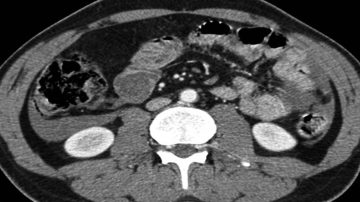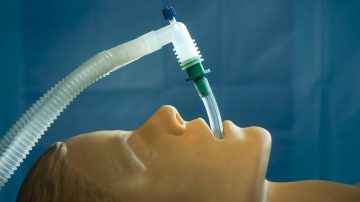The new direct target-specific oral anticoagulants (TSOACs; dabigatran, rivaroxaban, apixaban, and edoxaban) have been compared with vitamin K antagonists (VKAs; warfarin and similar agents) for acute venous thromboembolism (VTE) in six recent phase III clinical trials encompassing more than 27,000…
Read MoreIn a recent retrospective study from Mayo Clinic, researchers demonstrated that intravenous contrast material was not associated with acute kidney injury (i.e., increase in serum creatinine level of ≥0.5 mg/dL) during the 72 hours after computed tomography (CT) of the…
Read MoreAmong the 53% of patients with negative bronchoalveolar lavage results, alternative explanations for fever and for pulmonary infiltrates were established in 61% and 46%, respectively. Chest x-ray abnormalities, leukocytosis, purulent tracheal aspirate, or fever in a mechanically ventilated patient raise…
Read MoreA recent study concluded that assessing the ability of patients to list the months of the year backwards in addition to an assessment of subjective confusion and disorientation was accurate at diagnosing delirium in hospitalized adult patients. The months of…
Read MoreAli S. Raja, MD, MBA, MPH, FACEP reviewing Al Deeb M et al. Acad Emerg Med 2014 Aug. A meta-analysis demonstrates that ultrasound performs as well or better than other tests for the diagnosis of pulmonary edema in patients with…
Read MoreIn nonoperatively managed patients, ≈7% of patients had recurrent episodes, and 2% required emergency surgery during 4 years of follow-up. Some surgeons promote elective surgery after one or two episodes of uncomplicated diverticulitis to prevent recurrences that might require urgent…
Read MoreA large cohort study out of Denmark examining over 17,000 ER visits by adults determined that the absence of all three criteria fever, elevated CRP and SIRS criteria had a 99.5% negative predictive value for excluding bacteremia. Fever, elevated CRP level,…
Read MoreIn three single-center, randomized trials, oral contrast — given in addition to intravenous (IV) contrast — did not improve the diagnostic accuracy of computed tomographic (CT) scanning for suspected appendicitis. To determine whether this conclusion is generally valid, researchers analyzed…
Read MoreGuidelines recommend that patients with massive pulmonary embolism (PE) and hemodynamic instability be treated with thrombolysis (Circulation 2011; 123:1788). However, consensus is lacking on what to do in intermediate-risk patients (i.e., those who are hemodynamically stable but have right ventricular…
Read MoreNeedle decompression location Traditionally, needle decompression for the emergent treatment of a tension pneumothorax is the second intercostal space in the mid-clavicular line. This remains an option for needle insertion when you are treating a tension pneumothorax. This insertion point…
Read MoreA new randomized controlled trial refutes the theory that either Epogen or liberal transfusions will improve neurologic outcome in patients with traumatic brain injury. Head trauma occurs in 1.5 million Americans annually, at a cost of more than $56 billion. Erythropoietin…
Read MoreResults of the Syntax trial suggests that PCI and CABG have comparable results for most patients with left main disease. The results suggest that the all-cause mortality was lower with PCI vs CABG in patients with Syntax scores <=32, but…
Read MoreThere has always been some controversy about the utility of applying cricoid pressure (aka Sellick Maneuver) during rapid sequence intubation for the purpose of preventing aspiration. Theoretically, applying pressure on the cricoid cartilage posteriorly should occlude the esophagus against the…
Read MoreMore Tags – Deep vein thrombosis, deep venous thrombosis, DVT, DVT treatment, HPC updates, treatment
Outpatient treatment of acute DVT is as safe as inpatient treatment in patient’s with an adequate home situation. Cohort study of 13,500 patients diagnosed with an acute lower extremity DVT and treated with either low molecular weight heparin or fondaparinux.…
Read MoreDirect vs Video Laryngoscopy In 1878 William MacEwan first passed a tube into the trachea of an awake patient using his fingers as a guide. Now health care providers routinely perform endotracheal intubation as a life saving intervention. Despite over…
Read MoreCategories
- ACLS (1)
- Arterial line (33)
- Cardiovascular diseases (77)
- Central line (55)
- Chest Tube (39)
- Dermatology (4)
- Emergency Procedures (139)
- Endocrinology (6)
- Endotracheal Intubation (36)
- Events (24)
- FAST Exam (12)
- Featured (113)
- Featured Procedure (42)
- Gastrointestinal diseases (32)
- Ginecology (3)
- Glidescope Intubation (21)
- Hematology (33)
- Hospital Procedures (85)
- Infections (32)
- Intraosseous line (8)
- King Tube (27)
- Laryngeal Mask Airway (18)
- Lumbar Puncture (36)
- Mechanical Ventilation (34)
- Medical General (95)
- medical procedures (258)
- Needle Decompression (6)
- Nephrology (11)
- Neurological diseases (12)
- Oncology (4)
- Paracentesis (32)
- Pericardiocentesis (3)
- Procedural Sedation (19)
- Respiratory diseases (85)
- RUSH Exam (8)
- Thoracentesis (37)
- Traumatology (24)
- Travel (27)
- Ultrasound-Guided Peripheral IV (13)












